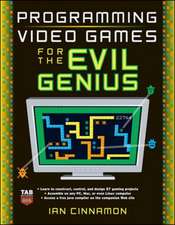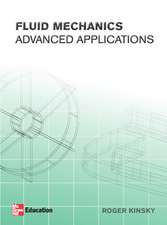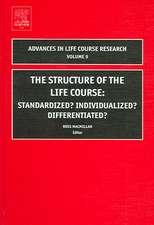File Interchange Handbook: For professional images, audio and metadata
Editat de Brad Gilmeren Limba Engleză Paperback – 10 aug 2018
For example, as many versions of one movie are needed (subtitle, TV or Airplane)a master file is now created with metadata controling which features (subtitles, editing) are needed.
This book is the authoritative work on all professional file formats for film and television, globally. Covers all major professional file formats, including the Digital Picture Exchange (DPX), General eXchange Format (GXF), Material eXchange Format (MXF), Advanced Authoring Format (AAF), QuickTime and Windows Media-in most cases by the lead author of the format.
Preț: 449.41 lei
Nou
Puncte Express: 674
Preț estimativ în valută:
85.99€ • 90.03$ • 71.15£
85.99€ • 90.03$ • 71.15£
Carte tipărită la comandă
Livrare economică 07-21 aprilie
Preluare comenzi: 021 569.72.76
Specificații
ISBN-13: 9781138375949
ISBN-10: 1138375942
Pagini: 324
Dimensiuni: 189 x 246 x 17 mm
Greutate: 0.45 kg
Ediția:1
Editura: Taylor & Francis
Colecția Routledge
Locul publicării:Oxford, United Kingdom
ISBN-10: 1138375942
Pagini: 324
Dimensiuni: 189 x 246 x 17 mm
Greutate: 0.45 kg
Ediția:1
Editura: Taylor & Francis
Colecția Routledge
Locul publicării:Oxford, United Kingdom
Public țintă
Professional Practice & DevelopmentCuprins
Intro--Brad Gilmer, Gilmer & Associates, Inc.
1. History / background--Hans Hoffman, EBU
2. Metadata dictionary--Oliver Morgan, Metaglue Corporation
3. Digital Picture eXchange (DPX)--Dave Bancroft, Thompson
4. General eXchange Format (GXF)--Bob Edge and Ray Baldock, Thompson Grass Valley
5. Material eXchange Format (MXF)--Jim Wilkinson, Sony, and Bruce Devlin, Snell & Wilcox, Ltd
6. Advanced Authoring Format (AAF)--Phil Tudor, BBC
7. Windows Media 9-Advanced System Format (ASF)--Nick Vicars-Harris, Microsoft Corporation
8. Apple QuickTime--George Towner, Apple Computer, Inc.
1. History / background--Hans Hoffman, EBU
2. Metadata dictionary--Oliver Morgan, Metaglue Corporation
3. Digital Picture eXchange (DPX)--Dave Bancroft, Thompson
4. General eXchange Format (GXF)--Bob Edge and Ray Baldock, Thompson Grass Valley
5. Material eXchange Format (MXF)--Jim Wilkinson, Sony, and Bruce Devlin, Snell & Wilcox, Ltd
6. Advanced Authoring Format (AAF)--Phil Tudor, BBC
7. Windows Media 9-Advanced System Format (ASF)--Nick Vicars-Harris, Microsoft Corporation
8. Apple QuickTime--George Towner, Apple Computer, Inc.
Notă biografică
Brad Gilmer is the Executive Director of the Advanced Authoring Format Association, a trade association charged with fostering interoperability in the rich media authoring environment. He was co-chair of the Pro-MPEG Forum's File Interchange Working Group on MXF and actively participated in the EBU/SMPTE Task Force. He is also President of Gilmer & Associates, Inc, a management and technology consulting company. Previously, Gilmer worked for 14 years at Turner Entertainment Networks.
Recenzii
"Brad Gilmer has assembled a timely and valuable reference work covering the technical and structural aspects of file formats and wrappers used for processing program content. The book provides a clear, concise description of the file wrappers together with valuable background and applications information. It has been tailored for the practicing engineer and technical manager. Chapters on the SMPTE Metadata Dictionary and the Advanced Authoring Format are particularly relevant. This book is a valuable reference work for every practicing broadcast and teleproduction engineer, every Information Technology professional, and those in the telecommunications field who are actively involved in the manufacturing, management, transport or delivery of media and entertainment content."
- Gavin Schutz, Chief Technology Officer, Ascent Media Group
"I found this book to be an excellent up to date reference manual and a "must read" for anyone currently involved in the design and implementation of multimedia facilities. It helped me to gain a better understanding of issues that must be addressed as we transition our stations from traditional base band audio video environments to a file based IT infrastructures."
- Ira Goldstone, VP chief technology officer Tribune Broadcasting
"In the mid '90s, CNN and other broadcasters recognized the need for standardized file exchange of broadcast material. Our technology plans mapped a path to an integrated production environment that was based on video files instead of video streams. With these new systems, we wanted to ensure that we could continue to leverage the best technology for the various parts of our production systems while taking advantage of more efficient content access. This created a strong need for open, standardized methods of exchanging video files that would support a variety of compressions and Metadata. These protocols needed to handle everything from simple file exchange to complex authoring formats for content in active production. Because of these needs, CNN pushed the industry to create several of the formats discussed in detail in this book and provided active user requirements during their creation. Within the next year, CNN will have systems in place that use MXF for file exchange between our production editing, playback and archive systems. And we have decided that all future systems will support MXF and AAF.
- Gordon Castle, Senior Vice President, CNN Technology
"Worldwide, the transition from traditional video systems to those based on IT is creating opportunities in all quarters. Enter the ubiquitous use of the file; files for archive, streamed files, just-in-time file transfers, proxy files, video server files, compositional metadata files, digital cinema files and the list goes on. Our industry was in desperate need for a file format guidebook until this reference came along. This is just what the doctor ordered. The formats in this book will become the cornerstones of all professional video systems for years to come. Don't get left behind. The file format train is leaving now and this book is your ticket to ride.
- Al Kovalick, Strategist and Pinnacle Fellow, Pinnacle Systems
"In the modern world of media production, storage and distribution, media files play a key part in any system or network. At the current time, new requirements and applications involving media files are constantly surfacing and several file formats are being actively developed or extended. This is an area of intense interest and activity within those industries involved in media creation, distribution and archiving. The range of file formats available can be confusing. What are the differences between them? What is the application space intended for each format? What are the strengths of each format? This book provides answers to all these questions. This book provides an in-depth introduction to six important file formats. It also gives good introductions as to why this field of work has become so important, in particular in the area of 'metadata' that gives detailed information about the material that is stored in the file. The individual chapters benefit from being written by leading experts involved in the development of the different standards. This book is essential reading for those who want an overview of the different formats. It is also essential reading for developers and users that need an introductory guide into the complexities of individual formats. This is an important, useful and timely book for those involved in the rapidly expanding field of media production, distribution and archiving.
- Dr. Nick Wells, Research Leader at BBC Research & Development and Chairman of the Pro-MPEG Forum
"Authoritatively written by key participants in the standards development activities, it provides a solid foundation for the future of the television and motion picture production industries. This book is the most up-to-date and only comprehensive technical overview available on television and motion picture production file formats and their application. It provides the context for understanding the referenced standards. I own copies of most of the standards explained in this book, but by providing not just the 'what or how' but the 'why' the authors have created remarkable clarity in this survey of a very complex subject, which is core to the future of our industry. The numerous illustrations add essential clarity to otherwise difficult to envision principles. Written to include readers of all backgrounds and interests, it will serve as a long needed bridge between the IT and traditional television and motion picture production communities. Regardless of your role in the IT or television and motion picture production industries from equipment and systems designers to maintenance engineers and including operations and production personnel you will benefit from this excellent treatment of the subject matter. This is not 'Bob's File Formats for Dummies,' it is rather an essential addition to the television and motion picture professions' educational and reference materials. I simply cannot imagine a successful file based television or motion picture production system implementation without this reference.
- Clyde Smith, Senior Vice President R&D, QA and Metrics, Turner Broadcasting System, Inc.
"This book is essential reading for either engineering or business professionals dealing with film and video file interchange. It is a confidence-builder for all levels. A useful introduction to physical equipment, it will equip someone about to encounter file based production systems for the first time with an appreciation of file formats in the workflow.
- Mike Cox, Mirador
"It is the only book that gives a complete scrutiny and breakdown of all file formats for the transfer of images, sound and metadata. - internetvideomag.com, October, 2006
- Gavin Schutz, Chief Technology Officer, Ascent Media Group
"I found this book to be an excellent up to date reference manual and a "must read" for anyone currently involved in the design and implementation of multimedia facilities. It helped me to gain a better understanding of issues that must be addressed as we transition our stations from traditional base band audio video environments to a file based IT infrastructures."
- Ira Goldstone, VP chief technology officer Tribune Broadcasting
"In the mid '90s, CNN and other broadcasters recognized the need for standardized file exchange of broadcast material. Our technology plans mapped a path to an integrated production environment that was based on video files instead of video streams. With these new systems, we wanted to ensure that we could continue to leverage the best technology for the various parts of our production systems while taking advantage of more efficient content access. This created a strong need for open, standardized methods of exchanging video files that would support a variety of compressions and Metadata. These protocols needed to handle everything from simple file exchange to complex authoring formats for content in active production. Because of these needs, CNN pushed the industry to create several of the formats discussed in detail in this book and provided active user requirements during their creation. Within the next year, CNN will have systems in place that use MXF for file exchange between our production editing, playback and archive systems. And we have decided that all future systems will support MXF and AAF.
- Gordon Castle, Senior Vice President, CNN Technology
"Worldwide, the transition from traditional video systems to those based on IT is creating opportunities in all quarters. Enter the ubiquitous use of the file; files for archive, streamed files, just-in-time file transfers, proxy files, video server files, compositional metadata files, digital cinema files and the list goes on. Our industry was in desperate need for a file format guidebook until this reference came along. This is just what the doctor ordered. The formats in this book will become the cornerstones of all professional video systems for years to come. Don't get left behind. The file format train is leaving now and this book is your ticket to ride.
- Al Kovalick, Strategist and Pinnacle Fellow, Pinnacle Systems
"In the modern world of media production, storage and distribution, media files play a key part in any system or network. At the current time, new requirements and applications involving media files are constantly surfacing and several file formats are being actively developed or extended. This is an area of intense interest and activity within those industries involved in media creation, distribution and archiving. The range of file formats available can be confusing. What are the differences between them? What is the application space intended for each format? What are the strengths of each format? This book provides answers to all these questions. This book provides an in-depth introduction to six important file formats. It also gives good introductions as to why this field of work has become so important, in particular in the area of 'metadata' that gives detailed information about the material that is stored in the file. The individual chapters benefit from being written by leading experts involved in the development of the different standards. This book is essential reading for those who want an overview of the different formats. It is also essential reading for developers and users that need an introductory guide into the complexities of individual formats. This is an important, useful and timely book for those involved in the rapidly expanding field of media production, distribution and archiving.
- Dr. Nick Wells, Research Leader at BBC Research & Development and Chairman of the Pro-MPEG Forum
"Authoritatively written by key participants in the standards development activities, it provides a solid foundation for the future of the television and motion picture production industries. This book is the most up-to-date and only comprehensive technical overview available on television and motion picture production file formats and their application. It provides the context for understanding the referenced standards. I own copies of most of the standards explained in this book, but by providing not just the 'what or how' but the 'why' the authors have created remarkable clarity in this survey of a very complex subject, which is core to the future of our industry. The numerous illustrations add essential clarity to otherwise difficult to envision principles. Written to include readers of all backgrounds and interests, it will serve as a long needed bridge between the IT and traditional television and motion picture production communities. Regardless of your role in the IT or television and motion picture production industries from equipment and systems designers to maintenance engineers and including operations and production personnel you will benefit from this excellent treatment of the subject matter. This is not 'Bob's File Formats for Dummies,' it is rather an essential addition to the television and motion picture professions' educational and reference materials. I simply cannot imagine a successful file based television or motion picture production system implementation without this reference.
- Clyde Smith, Senior Vice President R&D, QA and Metrics, Turner Broadcasting System, Inc.
"This book is essential reading for either engineering or business professionals dealing with film and video file interchange. It is a confidence-builder for all levels. A useful introduction to physical equipment, it will equip someone about to encounter file based production systems for the first time with an appreciation of file formats in the workflow.
- Mike Cox, Mirador
"It is the only book that gives a complete scrutiny and breakdown of all file formats for the transfer of images, sound and metadata. - internetvideomag.com, October, 2006




















